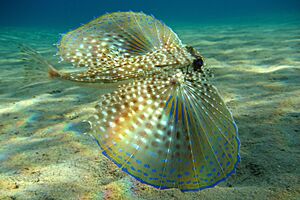Flying gurnard facts for kids
Quick facts for kids Flying gurnard |
|
|---|---|
 |
|
| Conservation status | |
| Scientific classification | |
| Genus: |
Dactylopterus
|
| Species: |
volitans
|
| Synonyms | |
|
|
The flying gurnard (Dactylopterus volitans) is a fascinating fish. It is also known as the helmet gurnard. This fish lives on the ocean floor in warm waters. You can find it on both sides of the Atlantic Ocean.
On the American side, it lives from Massachusetts in the north all the way to Argentina in the south. This area includes the Caribbean Sea and the Gulf of Mexico. On the European and African side, it ranges from the English Channel to Angola. It also lives in the Mediterranean Sea. The flying gurnard is the only species in its group, called Dactylopterus. Other similar fish, like those from the Dactyloptena group, live in the Indian and Pacific Oceans.
Contents
What Does a Flying Gurnard Look Like?
The flying gurnard has a unique appearance. Its body color can change. It might be brownish or greenish. It often has patches of red or yellow. This helps it blend in with its surroundings on the ocean floor.
Amazing "Wings" and Big Eyes
This fish has very special fins that look like wings. When it gets excited or feels threatened, it spreads these "wings" wide. They are partly see-through. The tips of these fins glow with a bright, beautiful blue color. This glowing effect is called phosphorescence.
The flying gurnard also has large eyes. These big eyes help it see well in the dim light of the ocean floor. It can grow up to 50 cm (20 in) long. It can weigh about 1.8 kg (4.0 lb).
Where Do Flying Gurnards Live?
Flying gurnards prefer warm, shallow waters. They live on sandy or muddy bottoms. They often hide among rocks or seagrass. This helps them stay safe from predators.
Habitat and Range
These fish are found in tropical and warm temperate zones. This means they like water that is not too cold. Their wide range shows they can adapt to different parts of the Atlantic Ocean. They are often seen near coastal areas.
What Do Flying Gurnards Eat?
The flying gurnard is a predator. It hunts for its food on the seabed. Its diet is quite varied.
Favorite Foods
Its main diet includes small fish. It also eats bivalves, which are creatures like clams. Crustaceans, such as crabs and shrimp, are another important food source. It uses its large fins to stir up the sand. This helps it find hidden prey.
How Do Flying Gurnards Behave?
Flying gurnards are known for their interesting behaviors. They are not true "flying" fish. Instead, they use their large pectoral fins in a special way.
Movement and Defense
When they spread their "wings," it's usually for defense. This sudden display can startle predators. It makes the gurnard look much bigger than it is. They can also use these fins to glide short distances above the seabed. This helps them move quickly to escape danger or find food.
They often walk along the bottom using their pelvic fins. These fins are strong and finger-like. This allows them to explore the seabed carefully.
Life Cycle of the Flying Gurnard
Like many fish, flying gurnards reproduce by laying eggs. Not much is known about their exact breeding habits.
Reproduction
Female gurnards release eggs into the water. Males then fertilize these eggs. The eggs float in the ocean currents. After hatching, the tiny baby fish, called larvae, develop in the open water. As they grow, they move closer to the seabed. They eventually settle down to live on the bottom as adults.
Conservation Status
The flying gurnard is currently listed as "Least Concern" by the IUCN. This means its population is stable. It is not considered to be at high risk of extinction.
Why They Are Not Endangered
Their wide distribution across the Atlantic helps protect them. They are also not a primary target for commercial fishing. This means fewer are caught by accident. However, like all ocean creatures, they can be affected by changes in their habitat. Pollution and climate change are ongoing concerns for all marine life.


